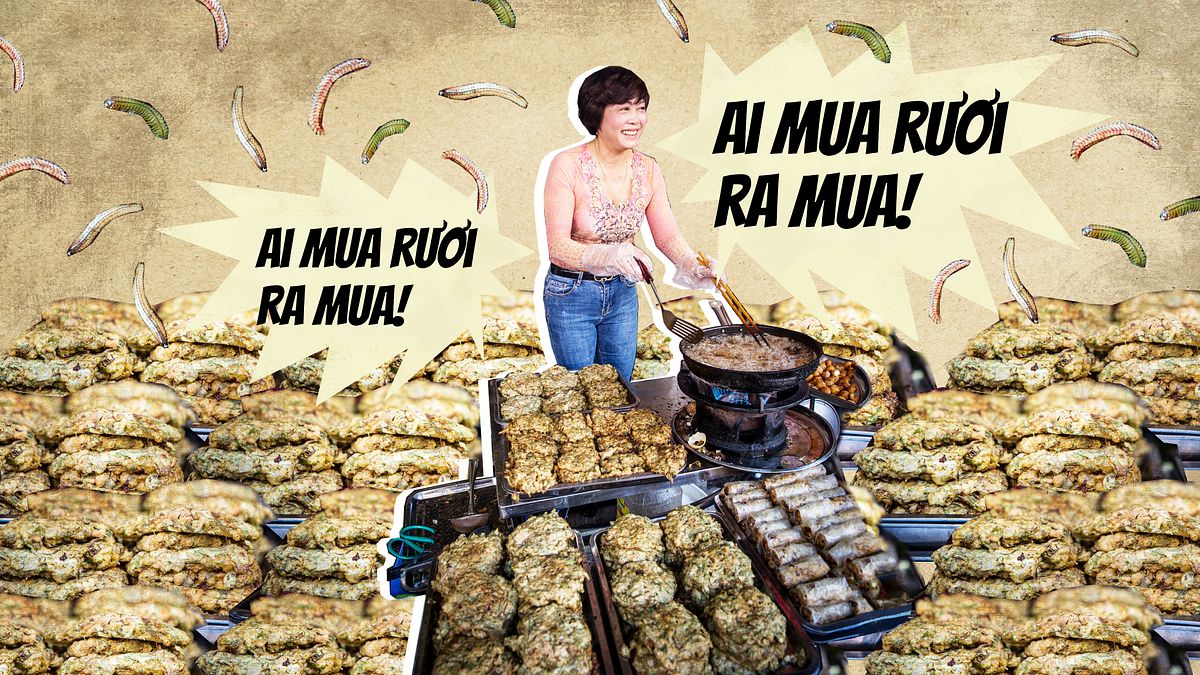Embedded in the street call of rươi vendors is the conjuring of autumn, when delectable cuisines from across the land of Vietnam come together on a dinner table.
Rươi vendors’ calls, similar to the prized worm itself, only appear for a brief time during the fall, particularly from the 9th to the 11th month on the lunar calendar when, as the owner of Hưng Thịnh, a famous chả rươi store in Hanoi, described: “The sky is above and the rươi are wiggling below.” Rươi is the Vietnamese name for palolo worm, an unsightly, two-inch-long sea creature that's the key ingredient of chả rươi, an omelete dish with tangerine peel, herbs, minced pork, and of course, chunks of rươi.
The seasonal appearance of rươi has been well-documented in Vietnamese literature. Vũ Bằng, a renowned journalist and writer, wrote fondly about the call of rươi vendors in a chapter specifically dedicated to rươi in his book, Miếng Ngon Hà Nội.
Vũ Bằng's depiction of the call of rươi vendors evokes the cultural imagination of Hanoi as an abundant culinary feast. The notion that plump and fresh rươi is mere footsteps away from the door of your home paints an all-too-comfortable picture about how a subset of Hanoians used to live. But all of that seems to be a memory of a distant past: the vivid and high-pitched sound of rươi calls in past Hanoi seems to have disappeared.

Live rươi sold in big duct-taped boxes. Photo via AFamily.
On a Saturday afternoon, I spent a couple of hours walking through Thanh Hà Market, Ô Quan Chưởng and Đồng Xuân Market to retrace the sound of rươi calls in the hope that I might find some insights into where this call has gone. I secretly wish that the rươi that I encountered looked a bit more like sandworms from Frank Herbert's Dune. However, instead of gigantic, tube-like and having impenetrable armour, the rươi that I saw at wet markets and food stalls were tiny, flat creatures at the mercy of Hanoian ladies’ swift hands. Out of the box and into the frying pan. They are certainly not the most attractive creatures on Earth.
In a distinctly Vietnamese cardboard box with blue duct tapes, the rươi specimens collectively wiggled their six-centimeter slimy bodies on top of one another. It must be some sort of bizarre joke from mother’s nature that their colors are subtly reminiscent of bàng leaves, with fiery red and a dark shade of green; and that their bodies are covered in miniature hairs that bring to mind those of rambutans.
Despite rươi being one of the less visually engaging critters, chả rươi and rươi vendors alike could not help but urge me to take photos of the rươi. The cashier at Hưng Thịnh told me to point the camera toward the rươi box, not forgetting to highlight the worms' freshness, plumpness, and “good-for-publication-ness.” Some vendors at Hưng Thịnh markets also proudly advertised that many young kids like taking photos of the rươi. Other rươi vendors were even under the impression that I approached them to make content for TikTok.
The people I met on my walk seemed divided as to whether or not the vendors from Vũ Bằng's writings still roam the streets of Hà Nội . The first seller I spoke to, a lady at Thanh Hà market, didn't recall hearing the sound of rươi vendors on local streets for the longest time: “Nowadays, people only sell rươi in stores. It’s rare to find street vendors these days.” She tucked her hands behind her back shyly when I asked if she could replicate the sound of rươi vendors, but then she smiled and happily hummed: “Ai mua rươi ra-à mùa.”
Is there a distinction between a rươi vendor and a poet? In a single call, the vendor manages to use consonance and alliteration — the “m” in mua, mùa, and the “r" in “rươi,” “ra" — to create a rhythmic effect in her call. By playing with the accents and modifying stresses with “ra" and “mua,” she infused music into her call. Simple in its effect, yet complex in its undeniably rich cadence, the call of rươi stands out among the eclectic corpus of Hanoi sounds.
While I was more than happy to hear the sound for the first time on Hanoi streets, I also wondered why it was that the call for rươi has gradually disappeared. Her theory was that the demand for live rươi is no longer as high as before. In the olden days, rươi vendors would carry their gánh across neighborhoods after their main session at the market to showcase the leftover rươi to local families, enticing homemakers — especially the women of the households — to purchase them in time for dinner preparation. It’s hard to imagine that happening nowadays with the changing social landscapes of Hanoi.
That afternoon I arrived in Hưng Thịnh, a famous chả rươi spot in Hanoi. Here, for VND75,000, you can get the bigger portion with rươi visible on the surface while the VND45,000 option tastes more like your standard cutlet. As she scooped out delicious, sizzling pieces of chả rươi from the hot oil onto a plate, I struck up a conversation about street calls. Unlike the lady at chợ Thanh Hà, she offered a different perspective on rươi vendors: “It’s not so much that rươi vendors and their calls have disappeared,” she said. “It is because they only appear on specific roads near the Old Quarters, where there would likely be more customers willing to buy rươi and process the rươi themselves.”
While walking across Đồng Xuân Market, I did pass by a rươi street vendor, đòn gánh on her thin back and bamboo baskets full of rươi before and in front of her, but she was passing by in silence. All around me, the noises of construction drills and motorbikes filled the atmosphere.
My brief search for the sound of rươi vendors’ calls ended up a meditation on what tiếng rao really means for Hanoi, for Saigon, the rising cities of Vietnam that are constantly negotiating between rubbles of its past and the high-rise buildings of the present. As the soundscape of urbanity — full of unattractive, dull, deafening noises — pervades our daily lives, the nostalgia of tiếng rao reminds us of a distant era when our hometown was more intimate and poetic.
















